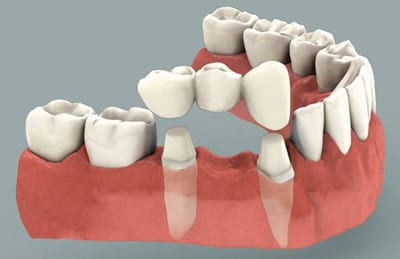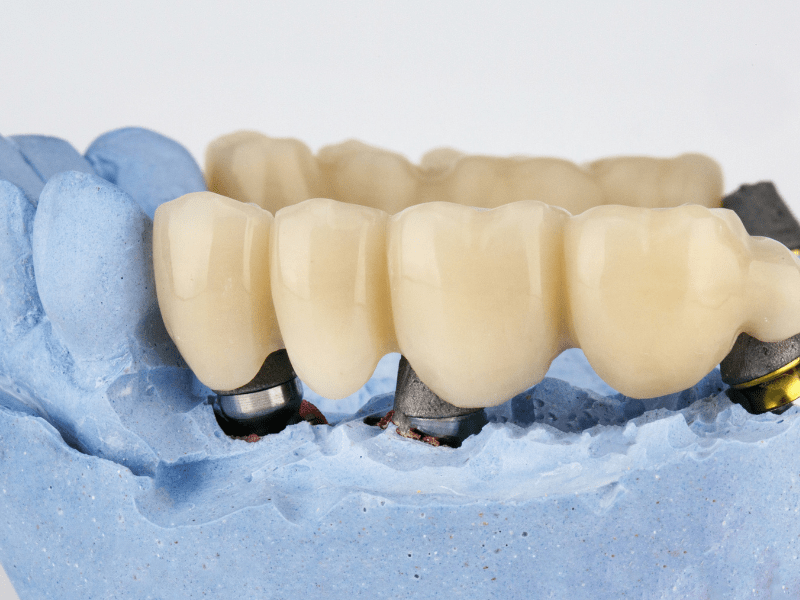Dental bridges are one of the ways by which you could replace a missing tooth with a prosthetic. As the name suggests, this is done not by fitting a removable tooth in the missing spot, but rather by creating a “bridge” by attaching a false tooth to the adjacent teeth.
Bridges work especially well for patients who are missing several teeth in a cluster because the same two attachments can replace the entire set.
Dental Bridge Material
Dental bridges can be crafted from a variety of materials, including:
- Gold, though it’s a relatively expensive choice;
- Metal alloys, which can be inexpensive, but which can stand out starkly when compared to normal teeth;
- Porcelain, a material less durable than metal, but more similar to teeth;
- A combination of the above. Porcelain fused to metal or PFM is a common choice because it can somewhat achieve the best of both worlds.
As with so many dental procedures, the benefits and drawbacks of each material vary, so before the procedure we will talk with you and recommend the best option for your particular case.
Common Reasons for Getting a Dental Bridge
Just like many other dental procedures, bridges have specific instances where they do better than others. We commonly recommend dental bridges for the following cases:
- Fill in a missing tooth, or a group of missing teeth
- Repair facial shape
- Fix chewing and speech issues resulting from missing teeth
- Prevent damage to neighboring teeth
- Avoid needing a removable denture
While bridges work extraordinarily well in some situations, however, there is an important caveat — dental bridges replace teeth at the cost of the health of the adjacent teeth. This is because the bridges have to be anchored somehow, and this typically means that the teeth next to the gap need to be shaved down and modified to accommodate the attachment.
Obviously, the dentist will make sure this adjustment doesn’t overly damage the teeth involved, but the trade-off is a consideration that you should think about when choosing between dental prosthetic options.
What Does the Dental Bridge Procedure Look Like?
Once you decide that a dental bridge is a right option for you, the real work begins. Your dentist typically begins by preparing the abutment teeth (described above) that form the boundaries of the dental bridge. The teeth that support the bridge must be carefully modified and “re-contoured” so that a dental crown can be fitted over them seamlessly in the future. This part of the procedure can sound scary but is quite safe.
After the teeth are prepared, a temporary bridge is typically attached to protect the area while your dentist begins to model and fashion the actual dental bridge. Because dental bridges are usually permanent, long-term attachments, accuracy, and precision are especially crucial. Your dentist will do everything he or she can to make the bridge resemble your own teeth as much as possible to minimize future complications.
When the bridge is appropriately finished, the dentist will remove your temporary bridge before installing and adjusting the permanent bridge. This adjustment period can take several visits. Our dentists want to make sure that the bridge fits perfectly. When the best shape has been achieved, he or she will cement the bridge in place, leaving you with a permanent dental prosthetic that returns full functionality to your teeth. Some variation is possible. For example, your dentist might decide to attach the bridge with dental implants rather than by placing dental crowns. But, for the most part, the procedure should resemble the one described above.

Questions about Dental Bridges?
If you’re missing any teeth, or if you just want to learn more about the procedure, you should talk to one of our qualified dentists! At Mint Dental Alaska, we’re more than happy to discuss your specific dental scenario and plan out the best treatment for you. Contact our office today to set up an appointment! We can be reached by phone at (907) 646-8670.







